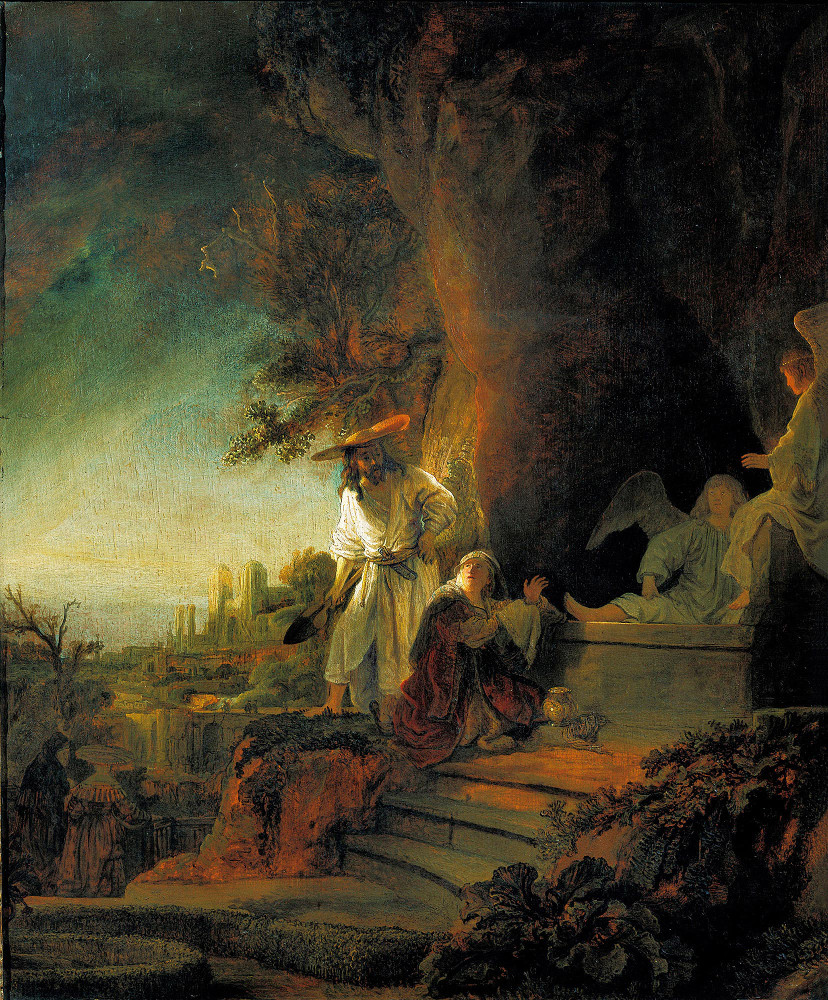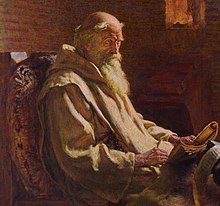
“The Risen Christ Appearing to Mary Magdalen” – which comes at the end of Holy Week…
Today is the start of Holy Week. (Also known as the last week of Lent.) And just as an aside, last year – 2015 – Easter Sunday came later, on April 4. (As noted in On Holy Week – and hot buns.)
The “hot buns” part of that equation noted that “’hot cross buns are traditionally toasted and eaten on Good Friday,’ in the Anglican countries of the British Commonwealth:”
A hot cross bun is a “spiced sweet bun made with currants or raisins and marked with a cross on the top.” The eating of this hot cross bun was designed to mark the end of Lent, with all its disciplines and “giving ups.” I.e., during Lent, only “plain buns made without dairy products” could be eaten. That prohibition ended at noon on Good Friday.
 The post also noted a number of superstitions from English folklore, about such “hot buns.” For example: Sharing a hot cross bun with friend “is supposed to ensure friendship throughout the coming year.” Also, if taken on a sea voyage, “hot cross buns are said to protect against shipwreck.”
The post also noted a number of superstitions from English folklore, about such “hot buns.” For example: Sharing a hot cross bun with friend “is supposed to ensure friendship throughout the coming year.” Also, if taken on a sea voyage, “hot cross buns are said to protect against shipwreck.”
But enough about those “hot buns.” (We are still in Lent, after all…)
More to the point, Holy Week includes – but is not limited to, spiritually speaking – the following Feast Days: Palm Sunday, Holy Wednesday (also known as Spy Wednesday), Maundy Thursday (Holy Thursday), Good Friday (Holy Friday), and Holy Saturday.” But here’s a key note:
Holy Week doesn’t “end” with Easter Sunday. By definition, Easter Sunday “is the beginning of another liturgical [season, 50 days long]…” That in turn could be a metaphor or object lesson for a whole new beginning, as in a “whole new way of life.” Which is another way of saying [that] Easter Sunday is the defining moment of the liturgical year…
See On Easter Season – AND BEYOND. That post noted that Easter Sunday – the end of Holy Week – is also known as Resurrection Sunday. For obvious reasons. It also included “a word about Rembrandt‘s interpretation of Easter morning, shown above:”
Mary Magdalen had just found Jesus’ grave empty, and asks a bystander what has happened. In her confusion she thinks the man is a gardener. Only when he replies with “Mary!” does she realize who she’s talking to. To illustrate Mary’s confusion, Jesus is often depicted as a gardener in this scene.
Then there’s the matter of Easter Sunday as celebrated today, “with the ‘Easter Bunny, colorfully decorated Easter eggs, and Easter egg hunts.’” (For a more liturgical view see What is Easter Sunday?) Which leads to the question: “So how did the Easter Bunny get mixed up in all this?”
The Easter Bunny (also called the Easter Rabbit or Easter Hare) is a symbol of Easter, depicted as a rabbit bringing Easter eggs. Originating among German Lutherans, the “Easter Hare” originally played the role of a judge, evaluating whether children were good or disobedient… In legend, the creature carries colored eggs in his basket, candy, and sometimes also toys to the homes of children, and as such shows similarities to Santa Claus or the Christkind, as they both bring gifts to children on the night before their respective holidays.
That’s from the Easter Bunny link, connected with the “bunny” postcard image at the bottom of the main text. There’s also a note that the Easter Bunny custom was first written of – in America – at about the year 1682. (See also social control, connected to similar practices before Christmas.)
Last year’s post – On Easter Season – AND BEYOND – also included a link to Ēostre – Wikipedia.
 That noted the “Germanic divinity” who originally served as “namesake of the festival of Easter.” And it noted that the “Ēostre” celebration was mentioned by the Venerable Bede – at left – in his “8th-century work The Reckoning of Time.”
That noted the “Germanic divinity” who originally served as “namesake of the festival of Easter.” And it noted that the “Ēostre” celebration was mentioned by the Venerable Bede – at left – in his “8th-century work The Reckoning of Time.”
But in closing, here’s a more incongruous note.
I was sitting in church this morning, listening to the priest read from Luke 22:14-23:56. (Part of the full Palm Sunday readings, which can be seen at Sunday of the Passion: Palm Sunday.) And for some reason, on this particular morning I was struck by Luke 22:37. That passage came right after Jesus said that Peter would deny Him three times before the cock crowed. Jesus went on to say – in our translation – “I tell you, this scripture must be fulfilled in me, `And he was counted among the lawless‘; and indeed what is written about me is being fulfilled.”
Biblehub.com has a number of different translations for the word “lawless:” Words like “transgressors,” or “rebels,” or “evil doers,” “criminals,” or even “outlaws.” And the notes thereto point to the “fifty third chapter of Isaiah, where this passage stands.” That 53d chapter is in turn “a manifest prophecy of the Messiah.” Specifically, see Isaiah 53:12:
Therefore I will give him a portion among the great, and he will divide the spoils with the strong, because he poured out his life unto death, and was numbered with the transgressors. For he bore the sin of many, and made intercession for the transgressors.
Another note pointed out that Jesus was “crucified between two thieves; and more than this.”
The more than this involved what might be known in the lawyer trade as a legal fiction. (That is, ” a fact assumed or created by courts which is then used in order to apply a legal rule.”) The legal rule in question demanded a blood sacrifice, under the Old Law, to cover the sins of the people. But to solve that problem for all time, Jesus substituted HIs own “blood” for ours:
[B]eing in the legal place, and stead of his people, and having their sins laid upon him, and imputed to him, he was made and accounted, by imputation, not only a sinner, but sin itself; and as such, was considered in the eye of the law, and by the justice of God… (E.A.)
Which is something to remember next Sunday, while enjoying those Chocolate Bunnies.
* * * *

“An Easter postcard depicting the Easter Bunny...”
* * * *
The upper image is courtesy of The Risen Christ Appearing to Mary Magdalen – Art and the Bible.
The lower image is courtesy of Easter – Wikipedia, the free encyclopedia.